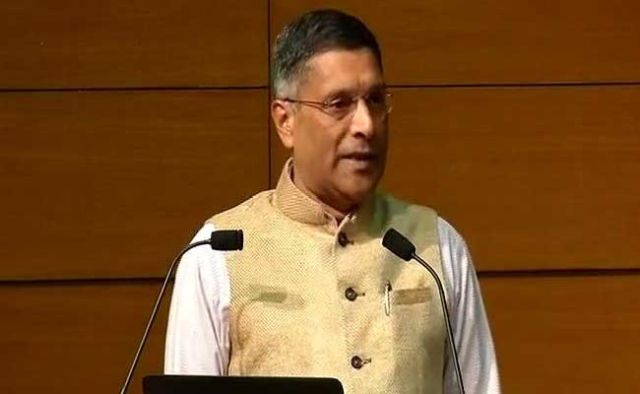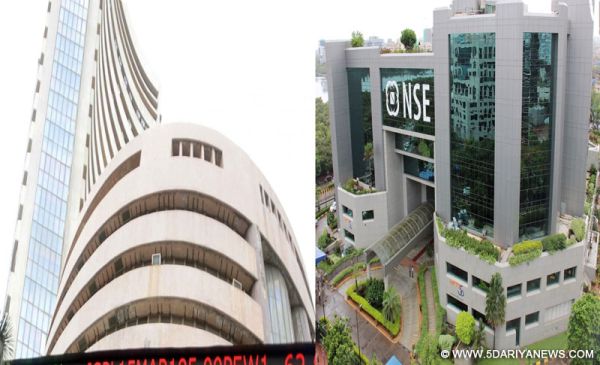
by Editor | May 25, 2021 | Banking, Corporate, Corporate Buzz, News, Politics

Arvind Subramanian
Chennai : With the second largest Indian bank Punjab National Bank (PNB) hit by massive $1.8 billion fraud and other banks hit by frauds as well, Chief Economic Advisor to Indian government Arvind Subramaniam on Saturday advocated more private participation in public sector banks.
Inaugurating the Annual Convention of the Madras Management Association (MMA) under the theme ‘India 2018-Learning to Grow’ Subramaniam said two questions have to be dealt with viz: “if not now, when and if not this, whether to have the same status quo in the banking system?”.
He said the Reserve Bank of India (RBI) had recently passed a series of regulations following the scandals and scams that affected the functioning of the banks. Bank of Baroda closed down its South Africa operations and now recently, PNB is facing problems.
Subramaniam said that while the government was going for recapitalisation of public sector banks, the scrutiny, monitoring and disciplined deployment must be ensured only through greater private participation in banks.
According to him, there should be less public lending to private sector and the mode to achieve that is to have higher private participation in the banking sector.
He said recognition, resolution, recapitalization and reforms are the answers to the questions.
Subramaniam said recognition is identifying stressed assets to avoid non-performing assets and resolution means to go through the bankruptcy code.
As to reforms, he said more privatisation could be made since there was no guarantee that better governance recommendations of banks, instead of privatisation, would be implemented effectively.
—IANS

by Editor | May 25, 2021 | Banking, Economy, Markets, News
 Mumbai : A massive sell-off in banking sector stocks pulled the key Indian equity indices — S&P BSE Sensex and NSE Nifty50 — lower on Wednesday.
Mumbai : A massive sell-off in banking sector stocks pulled the key Indian equity indices — S&P BSE Sensex and NSE Nifty50 — lower on Wednesday.
According to market observers, heavy selling pressure was witnessed in banking, healthcare and automobile stocks.
On Wednesday, the barometer 30-scrip Sensitive Index (Sensex) of the BSE receded by 144.52 points or 0.42 per cent to 34,155.95 points from Monday’s close. The equity markets were closed on Tuesday.
Similarly, the wider Nifty50 of the National Stock Exchange declined by 38.85 points or 0.37 per cent to 10,500.90 points.
In terms of the broader markets, the S&P BSE mid-cap index inched up by 0.17 per cent and the small-cap index by 0.16 per cent.
The intra-day trade saw the barometer Sensex touch a high of 34,473.43 points on the back of positive cues from global markets and a low of 34,028.68 points which was led by a massive sell-off in the banking sector stocks.
The BSE market breadth was bullish as 1,368 stocks advanced as against 1,470
declines.
“Markets corrected on Wednesday thereby resuming the intermediate downtrend,” Deepak Jasani, Head – Retail Research, HDFC Securities, told IANS.
“Selling accelerated in the afternoon session led by a drop in PSU banking stocks on the back of news that Punjab National Bank (PNB) had detected a $ 1,771.69 million fraud at a single branch in Mumbai.”
“Major Asian markets have closed on a positive note, barring the Nikkei and Straits indices. European indices like FTSE 100, DAX and CAC 40 are trading in the green.”
The massive-sell off in the banking sector stocks was triggered after the Reserve Bank of India’s (RBI) announced new norms to deal with the NPAs on Monday.
“The PSU banks witnessed sell-off as RBI scrapped a number of loan-restructuring schemes which may lead to further jump in provisions impacting profitability of these banks,” said Vinod Nair, Head of Research, Geojit Financial Services.
Besides RBI’s latest moves, the massive $1.8 billion fraud detected at one of the Mumbai branches of PNB, the second largest public sector bank in India also spooked investors.
“PNB fell 9.8 per cent as investors wondered about the impact of the fraud on the
profits or book value of the bank even as they await data about the
possibility and extent of recovery that is possible,” Jasani told IANS.
“If no recovery is possible, the impact could be Rs.42-46 per share out of which the stock price has already fallen — Rs 16 today.”
On a closing basis, the scrip of PNB closed at Rs 145.80, down by Rs 15.85 or 9.81 per cent from its previous close of Rs 161.65.
Apart from PNB, stocks of other lenders like Yes Bank, State Bank of India, Axis Bank and ICICI Bank were also impacted.
On the currency front, the Indian rupee strengthened by 22 paise to close at
64.09 against the US dollar from its previous close at 64.31.
In terms of investments, provisional data with the exchanges showed that foreign institutional investors sold scrips worth Rs 728.71 crore while domestic institutional investors off-loaded stocks worth Rs 152.39 crore.
—IANS

by Editor | May 25, 2021 | Banking, Corporate, Corporate Buzz, Corporate finance, Corporate Governance, Economy, Finance, Investing, Markets, News
 By Krishna SinhaChaudhury,
By Krishna SinhaChaudhury,
Mumbai : When it comes to digital transformation, sectors like the Banking, Financial Services and Insurance (BFSI), and telecom, will become the growth engines for India and IBM is ready to meet the technology requirements, a top company executive has said.
“The biggest growth for us is going to come from the financial services. We are going to consolidate telco and look at new revenue streams because telco is an industry that is turning on its head. There’s going to be a lot of conversations around integrated telcos which is getting into network domains,” Lula Mohanty, Managing Partner, IBM Global Business Services, told IANS in an interview.
IBM organised a two-day “The THINK Forum” here on February 12-13 attended by senior IBM and key business leaders from across the country who discussed the future of business and technologies that will shape the economy and society.
“The third vertical which we are very interested in is what’s going on in the domain of the retail industry in terms of Internet of Things (IoT) platforms as a service on products,” she noted.
When it comes to skilling and preparing a workforce for New-Age technologies like Artificial Intellignece (AI), robotics, Big Data and IoT, IBM is working with some of the state governments via skill development centres.
“We are also in talks with NITI Aayog and other learning and development organisations to understand what is the platform that we can put in place to skill more people,” Mohanty told IANS.
IBM recently announced a collaboration with the Telecom Sector Skill Council (TSSC) to spur emerging technology skills in the domestic telecom industry.
IBM’s student developers’ programme (career education) that infuses software capabilities that are industry-specific and market-relevant has helped more than 24,000 students and faculty members develop industry-relevant software capabilities.
Present in India since 1951, IBM India has expanded its operations with regional headquarters in Bengaluru and offices across 20 cities.
With the aim to help Indian enterprises deliver next-generation consumer experiences, global consulting agency Bluewolf, an IBM company, also announced a new practice in the country with “Salesforce”, a global leader in the customer relationship management (CRM) solutions.
The dedicated practice will leverage Bluewolf’s expertise and delivery capabilities in Augmented Reality (AR) and innovation strategy — combined with IBM’s leadership in cognitive and design-thinking with “Watson” — to help clients connect customer experience to value.
IBM currently manages 100-200 customers for the Salesforce practice in the country and expects the number to grow significantly in the coming years as enterprises and government agencies begin riding on digital transformation initiatives.
“India is one of the highest-growth markets for Salesforce,” said Sunil Jose, Senior Vice President and Country Leader, Salesforce India.
“We will continue to double our investments in the country. We welcomed our 1,000th employee in India in November last year. We will hire 1,000 more employees in Hyderabad alone by 2020,” Jose told IANS.
“We already have a strong base in Bengaluru, Hyderabad, Mumbai and Delhi. India is the market that is continuously growing for us,” Jose added.
Highlighting the strategy for the country, he said: “To drive business value, success and growth for its customers, Salesforce will focus on customer-centric digital transformation.”
The customer relationship management (CRM) solutions provider also has a “Centre of Excellence” in Hyderabad, which is its first major centre in India.
(Krishna SinhaChaudhury can be contacted at Krishna.s@ians.in)
—IANS

by Editor | May 25, 2021 | Economy, Markets, News
 Mumbai : Key Indian equity indices on Wednesday scaled record highs yet again as positive global cues, coupled with a strong rupee and robust buying activities in banking, metals and FMCG stocks, gave a boost to investor sentiments.
Mumbai : Key Indian equity indices on Wednesday scaled record highs yet again as positive global cues, coupled with a strong rupee and robust buying activities in banking, metals and FMCG stocks, gave a boost to investor sentiments.
According to market observers, expectations of upbeat quarterly results, as well as the latest report that India for the first time has moved into the top 100 in the World Bank’s Ease of Doing Business global rankings riding on sustained government reforms, added to the upward trajectory of the indices.
Both the indices breached their earlier record levels, both on closing and intra-day basis, scaled on October 30.
The broader Nifty50 of the National Stock Exchange (NSE) breached the 10,400-mark for the first time and stayed above that level on closing basis.
The Nifty50 rose by 105.20 points, or 1.02 per cent, to close at a fresh high of 10,440.50 points — cracking its earlier closing high level of 10,363.65 points.
On an intra-day basis, the Nifty50 scaled a new high of 10,451.65 points, surpassing its previous high of 10,384.50 points.
The barometer 30-scrip Sensitive Index (Sensex) of the BSE too closed at a fresh high of 33,600.27 points — surging 387.14 points or 1.17 per cent — higher than its earlier record closing at 33,266.16 points.
The Sensex touched a high of 33,651.52 points during intra-day trade, breaching its previous record high of 33,340.17 points.
The BSE market breadth was bullish — 1,516 advances and 1,274 declines.
“The Nifty closed above the 10,400 level for the first time. Banking and telecom stocks were in limelight. The Nifty witnessed a gap-up opening before touching new life highs as the session progressed,” Deepak Jasani, Head – Retail Research, HDFC Securities, told IANS.
“Market sentiments were boosted by the latest World Bank report, which elevated India by 30 notches at 100 in the World Bank’s Ease of Doing Business rankings. Positive global cues also supported the rally,” he added.
The broader market indices underperformed the BSE Sensex. The S&P BSE mid-cap index closed higher by 0.35 per cent and the small-cap index by 0.55 per cent.
Vinod Nair, Head of Research, Geojit Financial Services, said: “Market extended gain on account of continued buying in banks in expectation of credit growth and negating the concern on premium valuation. Telecom stocks are gaining positive sentiment in view of attaining attractive competition after tariff revision by key players.”
“Further, positive global cues and expectation of unchanged policy outcome from today’s (Wednesday’s) FED meet is providing a better way to the domestic market.”
On the currency front, the rupee strengthened by 15-16 paise to close at 64.59-60 against the US dollar from its previous close at 64.75.
“The benchmark indices ended the day at record highs on Wednesday after the index heavyweight Bharti Airtel hit its highest in nearly a decade post its September quarter numbers. Traders await the start of central bank meetings and the nomination of the next Fed chair,” Dhruv Desai, Director and Chief Operating Officer of Tradebulls, told IANS.
“Strong moves on banks — PSUs and private — along with metals, FMCG, and infrastructure stocks also added to the sentiment,” he added.
Sector-wise, the S&P BSE banking index surged by 568.76 points, followed by metal index by 277.96 points and FMCG index by 136.20 points.
On the other hand, the S&P BSE consumer durables index fell by 112.86 points, automobile index by 52.03 points and healthcare index by 22.92 points.
Major Sensex gainers on Wednesday were: Bharti Airtel, up 8.19 per cent at Rs 538.40; State Bank of India, up 4.58 per cent at Rs 319.80; ICICI Bank, up 4.42 per cent at Rs 313.20; HDFC, up 2.58 per cent at Rs 1,751.35; and Axis Bank, up 2.05 per cent at Rs 533.75.
Major Sensex losers were: Dr Reddy’s Lab, down 2.90 per cent at Rs 2,360.90; Power Grid, down 1.06 per cent at Rs 210.50; Hero MotoCorp, down 0.99 per cent at Rs 3,816.45; Sun Pharma, down 0.89 per cent at Rs 548.45; and Bajaj Auto, down 0.60 per cent at Rs 3,240.50.
—IANS

by Editor | May 25, 2021 | Branding, Business, Corporate, Corporate Buzz, Large Enterprise, Marketing Basics, Markets, Medium Enterprise, Online Marketing, SMEs, Technology
 By Nishant Arora,
By Nishant Arora,
New York : Buoyed by the demands from sectors like e-commerce, banking, telecom, government and other enterprises to store and scale up Big Data, global chip maker Intel is ready to help India achieve high-performance computing.
According to Lisa Spelman, Vice President and General Manager, Intel Xeon Processors and Data Center Marketing, Intel, the sheer size and scale of the country has always impressed her and the company with its next-generation processor portfolio is bullish on its future in the country when it comes to managing massive sets of data.
“The government has done an impressive amount of discussion in the area of high-performance computing. There is a talented developers’ community in India. Intel is ready to help the country achieve its high-computing goals when it comes to handling Big Data across the spectrum,” Spelman told IANS here.
Intel reported a record revenue of $14.8 billion in the second quarter this year.
The growth was witnessed in client computing (which was up 12 per cent) and data-centric businesses (which was up 16 per cent).
The Intel Data Centre business delivers almost half of Intel’s operating margin and is expected to grow revenue at over 15 per cent through 2018.
According to Intel CEO Brian Krzanich, the data centre is central to the company’s strategy and is a remarkable opportunity.
“By 2021, we expect the data centre to be a $65 billion silicon opportunity, and we’re less than 40 per cent of the total available segment today,” Krzanich said during the investors’ call recently.
To see its data centre business accelerate, India is a natural choice for the company.
Spelman is positive on the improved technological prowess and the presence of right talent in India.
“The several initiatives that the government and enterprises are offering today to help the people is remarkable. We have a strong engineering workforce and research and development facilities in the country to help the government realise its dreams,” she added.
In a short time, the Intel India Development Centre in Bengaluru has become a significant international design and development centre for the company.
The IIDC is Intel’s largest non-manufacturing site outside the United States, with over 2,500 engineers focusing on Intel’s core areas like application software and solutions, chip sets, communication software, graphic drivers and microprocessor, among others.
The newly-launched Intel ‘Xeon Scalable’ processors offer data centre customers huge performance gains for artificial intelligence (AI) and other data-intensive workloads.
The ‘Xeon Scalable’ processors offer 138 times deep learning performance gains and 113 times inference gains.
This means that the customers can do more inference on general-purpose hardware without the need for specialised accelerators.
The ‘Xeon Scalable’ processors also provide security without compromise.
Most of the top-notch firms like Microsoft, Amazon, Baidu etc are using Xeon processors to handle heavy data workloads.
Intel ‘Xeon Scalable’ processors are uniquely architected for the evolving data centre and network infrastructure.
These processors are designed to support an expanding range of existing and emerging data centre and network workloads, including cloud computing, 5G-ready networks and AI, delivering 2.2 times the performance over its predecessor.
“With this technology, India can leapfrog other mature markets in becoming a leader in the next generation data centre technology adoption,” the top Intel executive said.
Intel is also bullish on infusing AI and machine learning (ML) into its chips.
However, “when it comes to the chip architecture, AI is not yet fully settled and actually needs a broader portfolio,” Spelman noted, adding that Intel is constantly working towards making more efficient, industry-ready AI-enabled microprocessors.
(Nishant Arora is in New York at the invitation of Intel. He can be contacted at nishant.a@ians.in)
—IANS





